ARCHIVE · 2020
KATARINA ALAMAT KUSIJANOVIĆ
MENSURA
Duration: December 17, 2020 - February 28th, 2021
Curator: Petra Golušić
In an arch in the Sponza Palace, there is a Latin elegiac couplet:
Fallere nostra vetant et falli pondera meqve
Pondero cvm merces, ponderat ipse Devs
Our weights will not permit us to deceive or be deceived,
While I weigh the goods, God himself is weighing me.
.jpg)
Katarina Alamat Kusijanović uses these lines in a series of works and writes them out, cut up, i.e., fragmented, in works done in chalk on panel and in acrylic on Perspex. She reveals it in full only in two places, in the exhibition entitled Mensura, that is, measure.
Conditions for a perceptual failure to recognise the textual message are created, and this message becomes the starting point for and central motif of the works in which various universal problem areas of humanity, contemporary society, cities and places of the world, morality, freedom, truth are considered.
The modules are regularly and simply set up as frames of a polysemic saying interpreted disjointedly. It is at once endorsed and the reality is indicated in which the cancellation of its meaning, essence and existence unfolds.
Dubrovnik is the point of departure from which the motif is borrowed, so as to be able to use it to label and understand the condition of darkness and corruption of the spirit to which it has been brought, as have other cities in the world.
There is no noise and no strained emotion in the work of Alamat Kusijanović. It is simply and clearly critical without being condemnatory. What is presented is the ethical and cosmological vision that has come down from the inherited cultural heritage of the surroundings. The commercial policy of the Dubrovnik Republic had its own inscription that warned the measurers to be careful not to make mistakes, which is today particularly needful in all spheres of human work and activity. Commerce is today a mainly sullied space where horrors take place and the victim is human. Naturally there are scales that do not cheat and that in their calling are guided by the cause and point of everything that exists. Dubrovnik is made the subject, as a common place of the world, which suffers contemporary errors and which should be directed to correctness in order to justify all the qualities that were created in the past and that are suppressed in the present.
The universality of the work of the human being rests and is founded upon a renunciation of the self in the sense of surrender to the eternal which alone is truthful. Internal presence is demanding and is the basic task of every person; it is the possibility of being in truth, freedom, peace, purity… The measures are distorted at every level, it is concluded quietly and acutely and with great refinement in the works of Alamat Kusijanović.
The exhibition tells us of the collapse of the world and optimistically encodes the territory of the immortal.
.jpg)
MENSURA # 1, 2016
kreda, zlato, drvo, pleksiglas / chalk, gold, wood, plexiglass
53 x 53 x 11 cm
BIOGRAPHY
Katarina Alamat Kusijanović was born in Dubrovnik in 1965. She took a degree at the Education College in Belgrade, 1989, in the easel painting restoration and conservation section, and then in the Art Academy in Split in 2004. She has been a member of HDLU, the Croatian Artists Association, since 1992. From 1993 to 2019 she was employed as conservation/restoration adviser in the Croatian Conservation Institute and from 2008 to 2014 she was manager of the Dubrovnik Restoration Department. As staff member of the Croatian Conservation Institute she gave a series of lectures in professional and scholarly conferences at home and abroad. She has published two scholarly and a number of specialised works. She was the author of the exhibition installation Hidden Trecento (in front of the Rector’s Palace in Dubrovnik in 2018) and of the exhibition The Altar Painting of Jacopo Tintoretto from the Cathedral in Korčula (Rector’s Palace, Dubrovnik, 2008). Since 2008 she has worked as designer in the Adriatic Luxury Hotels group. She has exhibited at many solo and collective exhibitions. Katarina Alamat Kusijanović lives and works in Dubrovnik.
.jpg)
REFLEXIO CAERULEA # 2, 2020
akrilik, pleksiglas / acrylic, plexiglass
30 x 30 x 4 cm (48 x)
LOVRO ARTUKOVIĆ
DECELERATION
Duration: December 10, 2020 – February 28th, 2021
Organizers: The Art Pavilion in Zagreb and Museum of Modern Art Dubrovnik
In association with the Modern Gallery, Zagreb
Expert conception, selection of works, catalogue essay: Leonida Kovač
Curator in Dubrovnik: Jelena Tamindžija
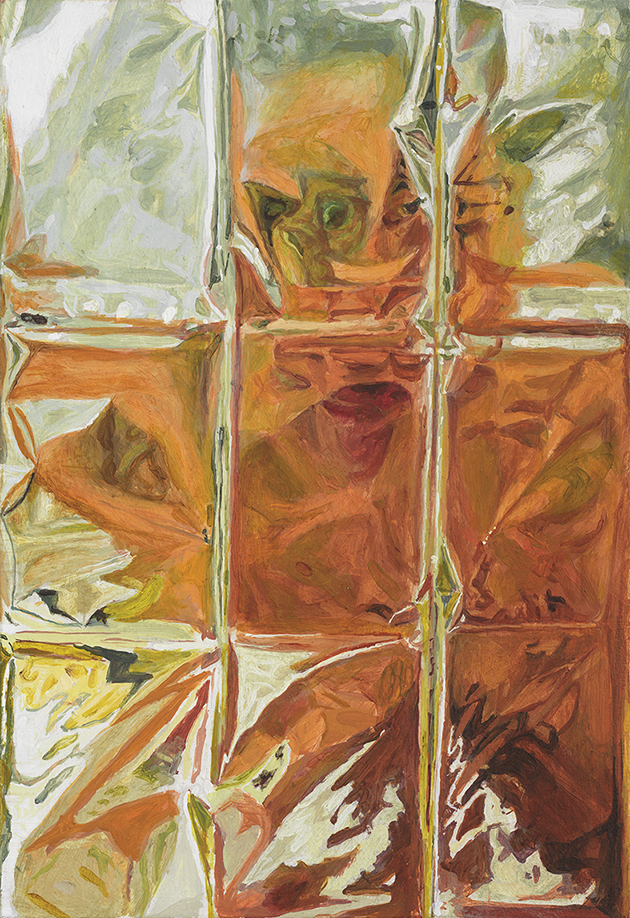 Biće iz bajke-kubističko, 2018., foto Gunter Lepkowski
Biće iz bajke-kubističko, 2018., foto Gunter Lepkowski
The Art Pavilion in Zagreb and Museum of Modern Art Dubrovnik are the joint organizers of the exhibition Deceleration in which, after many years, Lovro Artuković is presenting himself in Zagreb.
The exhibition should have been held in Zagreb in the Art Pavilion from mid-July to mid-September 2020, in the general framework of the cycle Ambiental Exhibitions of Contemporary Croatian Artists for the Art Pavilion. In the meantime, Zagreb was hit by the earthquake, which inflicted great damage on the Art Pavilion, because of which the gallery is closed until further notice. Therefore the exhibition is now on display in Zagreb at the Modern Gallery, for which we are most grateful to its director, Branko Franceschi.
Lovro Artuković has lived for years in Berlin, and had his last show in Zagreb in 2014 in Lauba. Since then in Zagreb, his native town, we have not had the chance to see works by this artist.
Artuković’s primary medium is figurative painting. In the creation of his works he uses the traditional technique of oil paint on large format canvases. This exhibition, too, includes large-sized paintings, but there are some new elements as well, related to the artist’s explorations in visual art. This has resulted in the great richness of detail in his recent works. The exhibition in Zagreb, and subsequently in Dubrovnik, is presenting 43 works created in the period from 2015 to 2020, and is divided into four sections: Golden Foils and Reflections; The Melancholy of Night Lights; Visit to the Studio; Excursion.
From the list of Artuković’s solo shows it can be seen that the painter exhibits but seldom and that his creative process is very lengthy, the works ultimately coming into being over a rather long period of time. Certainly, this artist cannot be accused of hyper-production, and he says of himself, quite to the contrary: “Big production is something that is completely unknown to me, I cannot create in that way”.
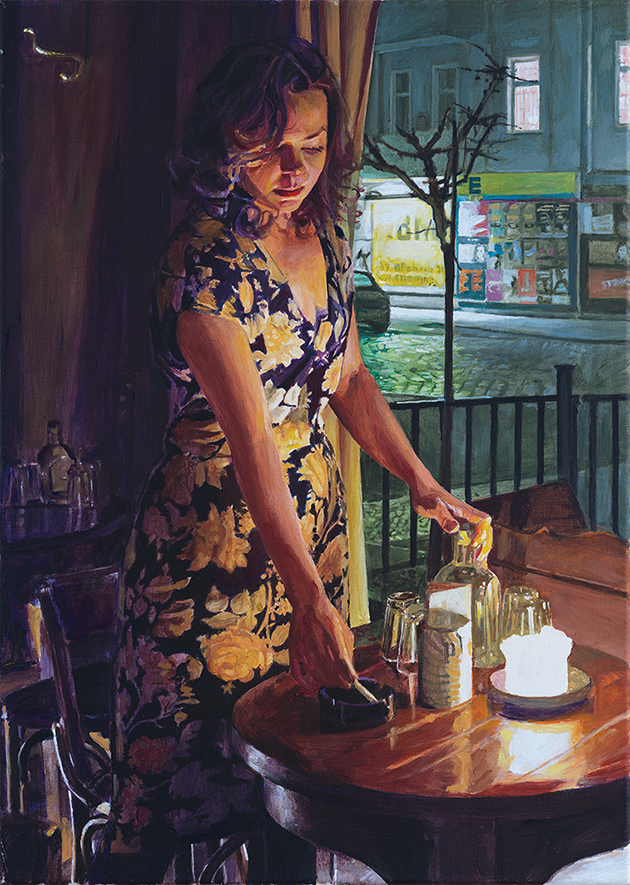 Haljina na cvjetove, 2019., foto Gunter Lepkowski
Haljina na cvjetove, 2019., foto Gunter Lepkowski
Lovro Artuković says about the title of the exhibition Slowing Down and also about his recent work:
“In the last few years I’ve been living in an incessant internal struggle. The fact is that my paintings, or the things I want to achieve with them, are taking up more and more time. I think one doesn’t need to find the reason in my getting older and generally slowing down, rather in the multiplication of details in the paintings, while the manner in which I paint – the countless applications of transparent paint in a single place so that I can obtain the presence and the density of what is painted that I want – takes hours and hours that just slip by imperceptibly. Seated for days in front of the same painting, enslaved to just a single detail, I often think that I ought to speed my painting procedure up, be more productive, work in key with the age in which everything unfolds at a frenzied speed, an age in which, I’m afraid, nobody anyway is going to have the patience or the concentration to engage in looking at my pictures with a slow, old-fashioned kind of pleasure.
Actually, I have got myself into this trap, as it sometimes seems to me. I have permitted the circumstances of life, and not some plan or system, to guide me in the choice of subjects, But when I look at what I have painted, I see that it had to be painted in just that way. For the sake of energy, of the atmosphere, for the sake of everything that I wanted, consciously or unconsciously, to achieve with each of these paintings. Since I haven’t (yet) invented a patent to permit me to paint simply and rapidly, while also being content with what is painted, at the end I always humbly acknowledge this slow and painful manner, even if it sometimes frustrates me, as my personal and identifiable manner. And so I decided to exhibit the paintings done in the last few years under the title Slowing Down.”
BIOGRAPHY
Lovro Artuković was born in 1959 in Zagreb, Croatia, and took his art degree at the Academy of Fine Arts in the same city. He has developed his painterly idiom, which is based on figuration and intimism, primarily on the iconography of urban civilisation. For some years he worked as a teacher at the Applied Art and Design School in Zagreb, subsequently, for nine years, being employed as assistant professor at the Academy of Fine Arts in Zagreb. In 2003, he moved to Berlin, where he makes his living as a freelance artist. He has had numerous one-man shows. He had his first solo exhibition in 1985 in the Vladimir Nazor Gallery. In 2008 he had a retrospective in Klovićevi dvori Gallery, entitled Best Paintings, which encompassed works done between 1984 and 2008. This exhibition was accompanied by an extensive catalogue of his works also entitled Best Paintings authored by Blaženka Perica (Klovićevi dvori Gallery, Zagreb, 2008). In 2001 he received the Annual Prize of the Croatian Artists Association, and in 2013 the Prize of the Public at the exhibition Macht Kunst, in the Deutsche Bank KunstHalle. Several distinguished art historians and critics have written of Artuković’s oeuvre, including Krešimir Purgar, Feđa Vukić, Leonida Kovač and Blaženka Perica . Two films have been made about it: the experimental film Theft directed by Lukas Nola of 2004, and the documentary L.A. Unfinished by Igor Mirković of 2008. His works are to be found in numerous public and private collections at home and abroad.
, 2020. Foto Gunter Lepkowski.jpg) Ukazanje u Neukollnu (crveno, žuto, zeleno), 2020., foto Gunter Lepkowski
Ukazanje u Neukollnu (crveno, žuto, zeleno), 2020., foto Gunter Lepkowski
THE OTHER CITY
A Selection of Works by Contemporary Artists from Split and Dubrovnik
Duration: 7.11.2020. - 6.12.2020.
Collaboration between Museum of Modern Art Dubrovnik and Museum of Fine Arts Split
Curated by Jasminka Babić, Rozana Vojvoda
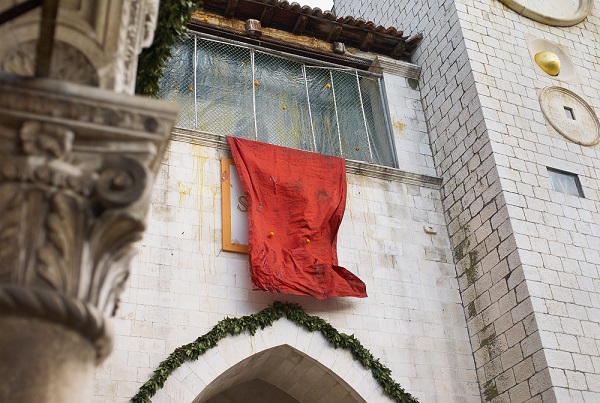 Marko Ercegović, Dubrovnik, 2010., iz serije Sve ili ništa
Marko Ercegović, Dubrovnik, 2010., iz serije Sve ili ništa
Artists: Gildo Bavčević, Valentino Bilić Prcić, Duška Boban, Pasko Burđelez, Viktor Daldon, Tanja Deman, Ivana Dražić Selmani, Rino Efendić, Marko Ercegović, Tina Gverović, Ivana Jelavić, Ana Kuzmanić, Toni Meštrović, Ana Opalić, Ivana Pegan Baće, Vedran Perkov, Luko Piplica, Boris Poljak, Viktor Popović, Ana Požar Piplica, Kristina Restović, Neli Ružić, Lana Stojićević, Slaven Tolj, Ivona Vlašić.
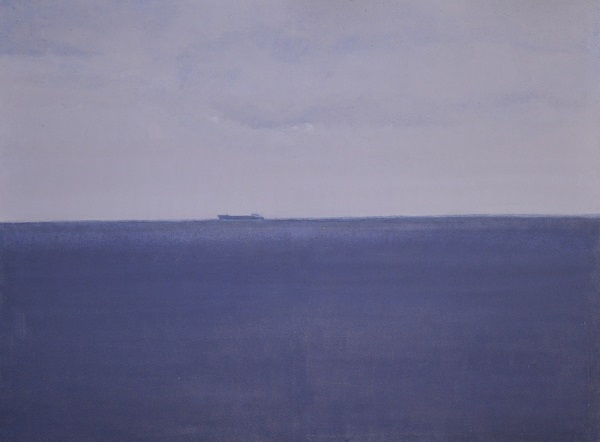 Ivona Vlašić, iz serije Nigdje između, 2010.-2017.
Ivona Vlašić, iz serije Nigdje između, 2010.-2017.
The exhibition opens up a dialogue between artists from Split and Dubrovnik about common themes, primarily the issue of living in cities that the galloping development of tourism has turned into destinations, disposable places, souvenir shops and backdrops for the hugely expensive productions. It presents artists who in a more or less transparent way, although always complex and never couched in the simplifications of the pamphlet, speak out about the threat to public space, the conversion of homes into holiday lets, the concreting over of the coast, the race for money, inverted values and new phenomena like the ever more frequent retreat of citizens into the last oases of humanity before the stampede of tourists.
The selection of artists from Split in terms of generations covers artists who started in their work from the late 1980s to start thinking about their environment, via those who in coming back to Split in the early 2000s began, in their art and teaching, to reshape the Split scene irrevocably, correlating it with appropriate Croatian and international phenomena in contemporary art. And finally there are the members of the youngest generation – graduates of the Split Art Academy whose work has kept them tightly connected with Split, guaranteeing at the same time the maintenance of this sometimes demanding but nevertheless genuinely live artist community. The diversity in media, form and concept tells of the absence of any dominant trend, and genuinely provides the ability for the complexity to be experienced, in the life of the city, and in the practices of its artists. Irrespective of whether we are concerned with discourses closely connected with social activism or with muted examples of contemporary flâneurism, the approach all the selected artists have in common is that with their deeply pondered research and works they stand out against the superficial, trivialised and stereotyped ideas of contemporary Split.
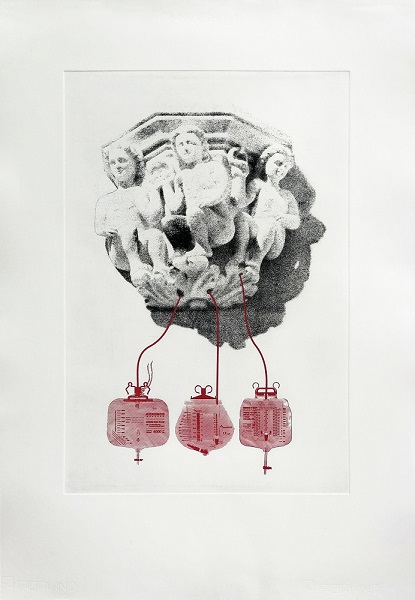
Kristina Restović, Male milosti i kateteri, 2020., bakropis, suga igla i sitotisak
The artists chosen to represent the contemporary Dubrovnik art scene belong almost entirely to the middling generation the formative years of which were connected with the Lazareti Art Workshop, founded in 1988. With its innovative artistic practices, exhibiting in public spaces and the guest appearances of a very large number of diverse international and national visual artists, directors, musicians and theoreticians, Lazareti had a huge impact on the development of contemporary art in Dubrovnik. Even if in large part they no longer actually live in Dubrovnik, through their art practices they are still connected to the city and its problems, keep up a lively and active communication with the setting, mostly in the media of photography, video and installation. In common to all these artists is systematic work on the re-examination of reality in a social and metaphysical sense, the problematization of the conventions of the media that they use, and an active and creative communication with the Dubrovnik and wider Mediterranean ambience.
, 2018..jpg) Viktor Popović, Bez naziva (Arhiv ST3 Sadržaj), 2018.
Viktor Popović, Bez naziva (Arhiv ST3 Sadržaj), 2018.
MATO CELESTIN MEDOVIĆ
Exhibition marking the centenary of artist’s death
/from the MOMAD collection
Duration: 22.10.2020.-31.1.2020.
Curator: Rozana Vojvoda
South-westerly, around 1906., oil on cardboard
The Collection of Dubrovnik Museum of Modern Art holds thirty-four works1 by Mato Celestin Medović – on the whole portraits, some works with religious subjects, and landscapes, as well as various sketches and studies. Some of the works from the collection are reckoned to be among the finest that Medović created. The generic diversity that characterises Medović’s works in the Museum of Modern Art in Dubrovnik reflects, in fact, something that has never been sufficiently accentuated – that Medović was an artist who produced works of great quality in various fields of activity – in history painting, and in the religious, portrait and landscape genres.
Rozana Vojvoda
Motif from Pelješac, 1906. – 1908., oil on cardboard
BIOGRAPHY
Mato Celestin Medović was born on November 17, 1857 in Kuna, a village on the peninsula of Pelješac. After a year of education at the Franciscan Monastery of Our Lady of Loreto (Delorita) on Pelješac, in 1868 he left for the monastery of the Minorites in Dubrovnik, where he entered the novitiate. There, he started doing drawings and painting in oil, and in 1880 went off to study painting in Italy. He had private lessons in Rome from 1880 to 1882 (Ludwig Seitz, Francesco Grandi), and then from 1883 to 1884 in Florence (Antonio Ciseri). In 1886 he returned to Dubrovnik, but aware of the shortcomings of his incomplete training in 1888 he went to the Academy of Fine Arts in Munich (his teachers were Gabriel Hackl, Ludwig Löfftz and Aleksandar Wagner). The three last years spent in the class of Wagner left the deepest trace from this period, in the spirit of the decorative historical compositions of Karl Piloty. He spent 1893 to 1894 in Dubrovnik and Kuna, and left the order. After Munich, his conception for the making of religious paintings underwent fundamental modifications. Details of setting were rejected, and the paintings were dominated by the monumental figures of the saints. He spent 1895 to 1907 in Zagreb, where under the influence of the plein air thinking and rich colourism of Vlaho Bukovac he changed his brushstroke and invigorated his colours. He is the first of the modern Croatian painters to have emancipated still life as a freestanding subject, which also goes for landscape, which he mainly painted on Pelješac, in plein air, with a bright scale of pure colours. This new visual expression was transferred also to the historical compositions, to paintings with religious subjects and portraits. In 1908 when he returned to his native Kuna, a new period in the painting of Celestin Medović started, forming what is called the Pelješac phase, interrupted by a brief period in 1912 to 1914 when he lived in Vienna. In this period he painted almost entirely landscapes, abounding in the bright southern light and in vigorous colours, with which he made his greatest contribution to Croatian painting. Mato Celestin Medović died on January 20, 1920, in Sarajevo.
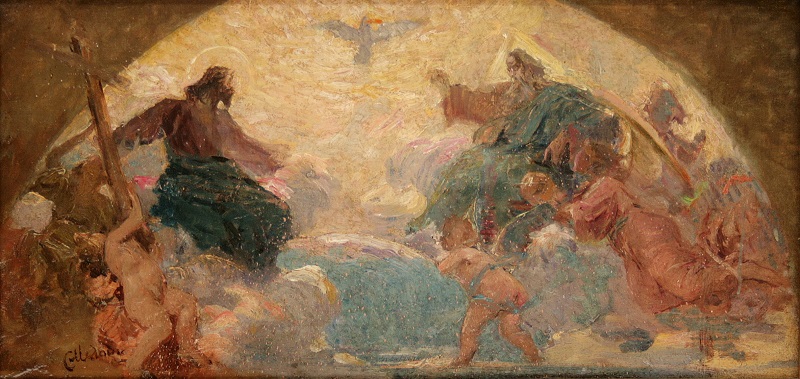
Holy Trinity (sketch for a fresco), 1899., oil on canvas
IVONA ŠIMUNOVIĆ
RIFTS IN REALITY
Duration: 13.8.2020.-18.10.2020.
Curator: Jelena Tamindžija
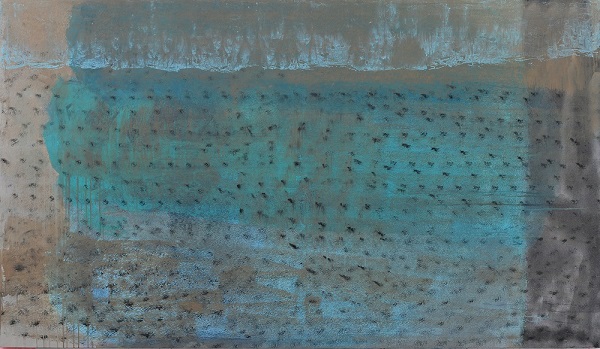
Stars above, 2020, acrylic on canvas, 230 x 130 cm
A fear of the split of reality and the observation of outside space through the opening of Plato’s cave paralyses the individual and stops him accepting the polyvalent nature of man and his own clefts as part of the narrative. Suppressing thoughts, speech and feelings results in the recreation of an uncontrolled chaos and a tendency to connect up the fragments. Šimunović consciously accepts this apparent chaos as inherent to human nature and as driver of the stream of thoughts that will embody this thinking process with large canvases. The works that defy the acceptance of a single determinant are placed at the entrance to the cave showing several worlds and the way they are read. Abstract forms that like Rorschach blots actually examine the status quo of reality take over the role of translation, ripping it rebelliously and unpredictably like the gusts of the north easterly creating rifts within which we find ourselves, never ultimately defined and never ultimately understood.
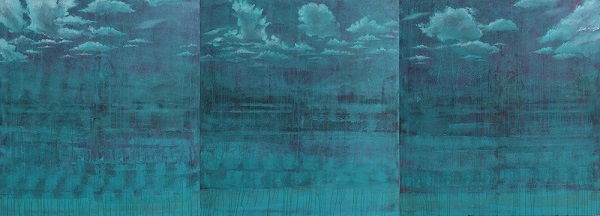
Tearing up clouds, triptych, 2018, acrylic on canvas, 390 x 140 cm
BIOGRAPHY:
Ivona Šimunović was born in Dubrovnik in 1979. Here she had her secondary education at the Luka Sorkočević Art School, painterdesigner major. She also took a degree at the Academy of Fine Arts in Zagreb, class of Zlatko Kauzlarić Atač. She is not only a painter, but also an educator. She has worked as a teacher of visual culture in elementary school, has led numerous art workshops for children and adults, and is currently museum educator in the Dubrovnik Museum of Modern Art. She has been a member of the Croatian Artists Association since 2006. She has exhibited in solo and collective shows in Dubrovnik, Pag, Lopud, at the Vizura Aperta Project on Pelješac in 2019. She lives and works in Dubrovnik and her works can be found in private collections in Croatia and abroad.
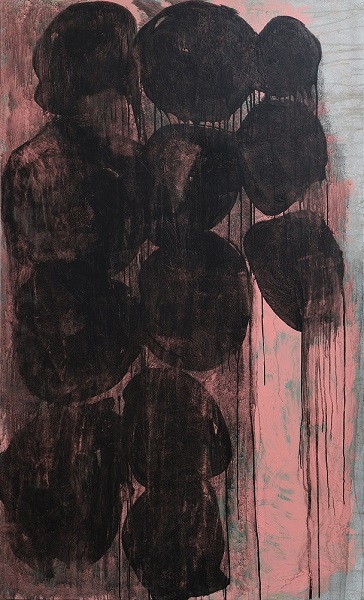
Geometry of the Impossible, 2020 acrylic on canvas 200 x 120 cm
ANA OPALIĆ
PORTRAITS
Duration: 2.7.2020. - 9.8.2020.
Curator: Rozana Vojvoda
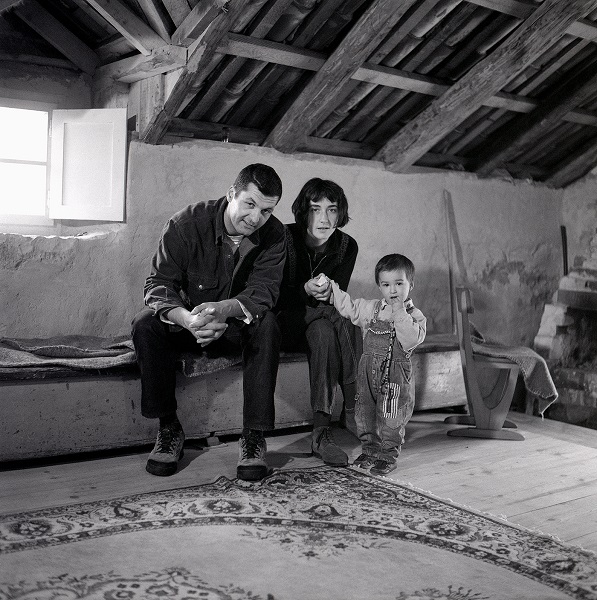 Luko, Ana, Jakov, Konavle, Spring, 1998.
Luko, Ana, Jakov, Konavle, Spring, 1998.
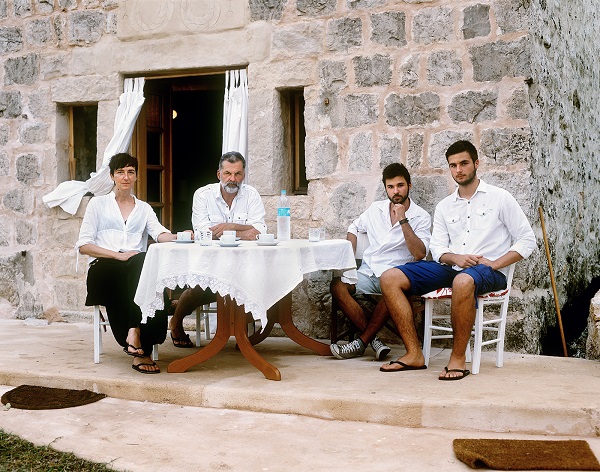
Ana, Luko, Jakov, Andrija, Konavle, Summer, 2016.
Portraits is a photographic series that Ana Opalić shot over a long period of time (at this exhibition, the interval from 1997 to the present day) that has to be taken as work in progress or even as a lifetime project. There is the continued process of the artist positioning herself and communicating with the world and the people that surround her, of the “capture” of man in the time that shapes, models and changes us. Since the artist photographs people close to her, family members and friends, this is an intimate act, a recapitulation of relations, communication that she establishes with her other gaze, with the revealing lens of the camera.
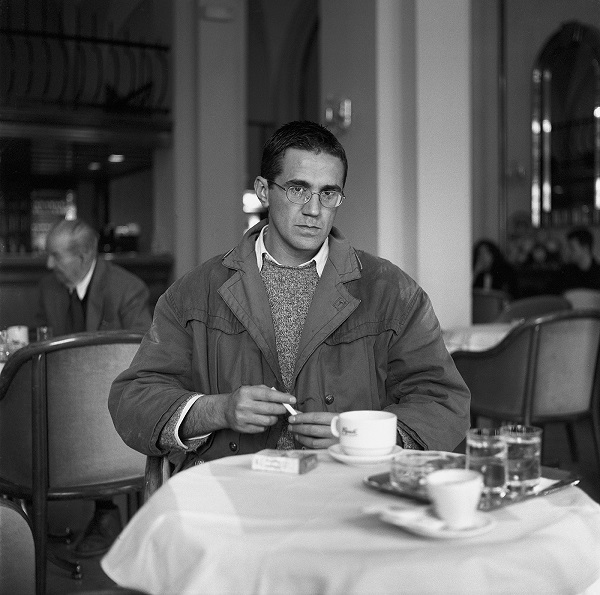
Slaven, The City Café, Dubrovnik, Spring, 1998
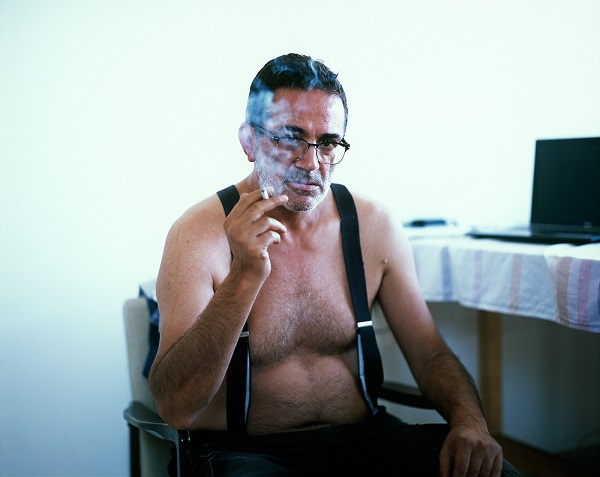 Slaven, Rijeka, Summer, 2016
Slaven, Rijeka, Summer, 2016
BIOGRAPHY:
Ana Opalić was born in 1972 in Dubrovnik. In 1997 she took a degree in TV and film cinematography at the Academy of Dramatic Arts in Zagreb. Her work takes in photography, video and documentary film. She has exhibited solo since 1991. In 2003 she represented Croatia at the Venice Biennale (with Boris Cvjetanović). She won the 2nd prize in the 2009 T-HTnagrada@msu.hr competition exhibition. In 2016, with co-author artist Vesna Mackovic, she took the 3rd prize at the T-HTnagrada@msu. hr competition exhibition. She is the founder of the Web portal www.croatian-photography.com. She was director and cinematographer of two documentary films: Once More (Ana Opalić and Noah Pintarić, 2014) and Medicine, 2018, first screened at the Zagreb Dox and the Dok Leipzig film festivals. She has published two books of photographs: Brsalje, 2017, and Dom [Home], 2018, and, in a joint project with the architect David Kabalin, the book The Dubrovnik Caravan Route, 2019. She lives and works in Zagreb.
DIALOGUES - MODERN AND CONTEMPORARY ART: exhibition from the collection of the Museum of Modern Art Dubrovnik
Duration: 5.6.2020.-31.10.2020.
Curator: Rozana Vojvoda
.jpg)
.jpg)
The exhibition DIALOGUES - MODERN AND CONTEMPORARY ART: exhibition from the collection of the Museum of Modern Art Dubrovnik presents a selection from the gallery’s collection that today counts over 2,700 works of art, covering the period from the late 19th century to the present. The three floors of the Villa Banac, one of the most beautiful buildings of Croatian modern architecture, are packed with works of art that include reflections of Impressionism, Expressionistic and Coloristic tendencies, abstract expression of the organic and geometric type of the fifties and sixties, postmodern painting tendencies of the eighties and art of expanded media that includes photography, video, and performing arts.
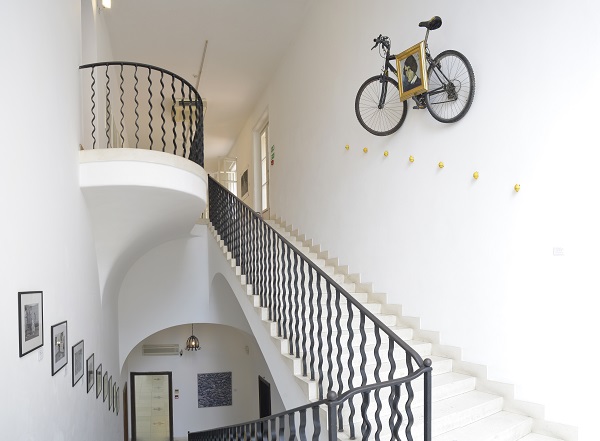
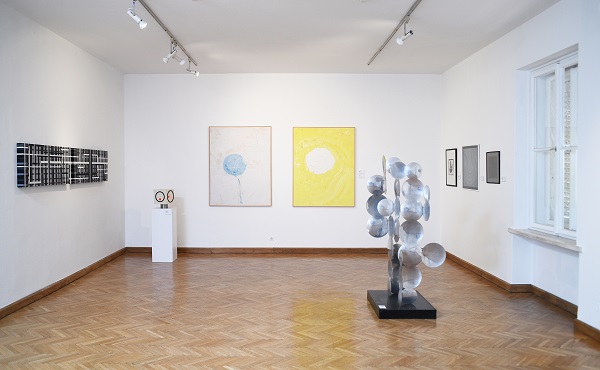
This exhibition is an opportunity for numerous domestic and foreign guests, who visit Dubrovnik in large numbers to visit and discover the quality and stylish pluralism of modern and contemporary art represented in the collection of the Dubrovnik Museum of Modern Art.
REMARKING THE CITY: : exhibition from the collection of the Museum of Modern Art Dubrovnik
Duration: 18.5.2020. - 28.6.2020.
Curator: Jelena Tamindžija
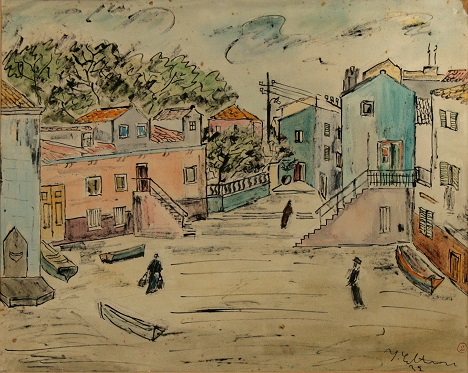
Ivan Ettore U Pilama 1932. g. akvarel i tuš, papir
The exhibition "Remarking the City" opens in special circumstances at the Dulčić Masle Pulitika Gallery, at a time when the famously crowded streets of Dubrovnik are being replaced by restrictions and limited movement that affect the local identity of the city itself. On the other side of the mirror, the exhibition "Remarking the City" reminds us of the basics of that identity, a picture of a city teeming with liveliness like Gusić's and Šerbu's Stradun full of walkers or Pulitika's market where the Mediterranean murmur of vendors in characteristic costumes is felt. It is a city that is inscribed in the mental images of the inhabitants through works of art, a city in whose old city center the artists themselves and their ideas appear as interpolations. The city of simultaneous polemics on the literary scene and the fisherman's square, loud conversations in the studio of Đuro Pulitika in the fortress of St. Ivan, the city of literary criticism with Krleža in Strajnić's apartment in Za kapelicom 4, a city that welcomes the morning light through Dulčić's stained glass windows in the church of Sv. Vlaho, and ends with loud applause in the evening theater program under the ceiling of Vlaho Bukovac. All these artists have inscribed the city in their fabric and made it possible to print a memorandum on which new generations continue to build their identity. ”
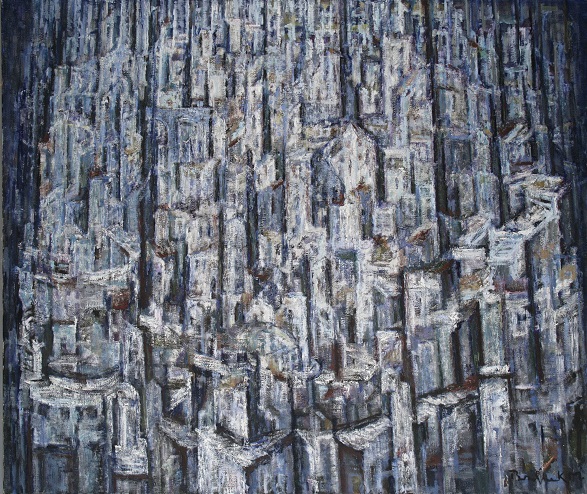
Bosiljka Kovaĉević-Mijatović Dubrovnik 1974. g. ulje, platno
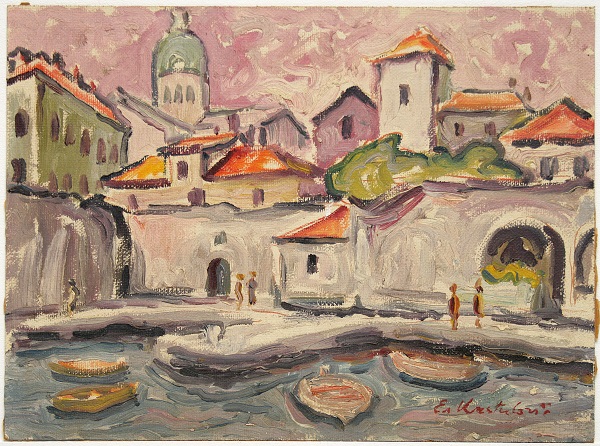
Eugen Krstulović Gradska luka oko 1950. g.
ĐURO SEDER
SEDEROTONIN
Duration: 5.3.2020.-31.5.2020.
Curator: Feđa Gavrilović
Assistant Curator & Exhibition Layout: Jelena Tamindžija
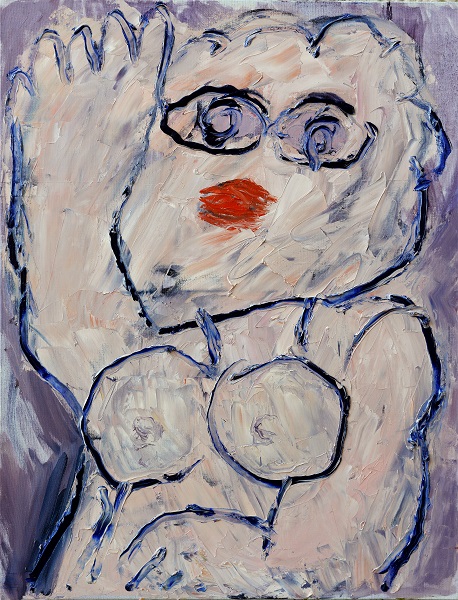
Hello Houellebecq, 2019, oil on canvas, 90 x 70 cm
The depressed main character, who can see no purpose in life, withdraws at the end into an apartment in a Parisian skyscraper and waits for death. He has one disastrous apercu after another, alternating with phases of powerful mental pain and remorse for the chances he has missed in life. One of these apercus relates to the classics of literature. Both Mann and Proust, realises Houellebecq’s sorrowful protagonist, found the only high point in life in the eroticised beauty of youth. His own wanderings around the wastelands of his existence have led him to the state in which he rejects any kind of ecstasy, knowledge or beauty, apart from the sexual kind, which is as transitory as a bloom and is anyway inaccessible to him because of the tablets he takes for his depression. The only joy he has is in eating various kinds of hummus, and serotonin, the hormone that encourages the feeling of happiness, is produced only via the anti-depressives. The whole construction of this sorry individual corresponds in an uncommon way with the oeuvre of Đuro Seder.
Feđa Gavrilović
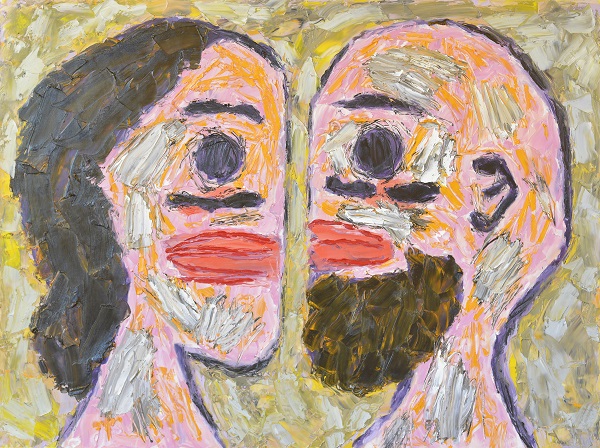
Towards the Man 1, 2019, oil on canvas, 120 x 160 cm
Quite simply, the spirit of the time flowered through Seder’s experience. The artist did not give up before its destruction, did not allow it to crush him into the state of inactivity into which, with their years and growing reputations, numerous of his fellow painters of all generations did fall. Just as the protagonist of Serotonin (fairly unexpectedly) at the end of his story mentions the principal figure of the New Testament, in Seder’s painting from the mid 1970s there is an increasing presence of Christian motifs. Perhaps he heeded his intuition and began to look at the world around him, admire it and taken from it just the finest and the most beautiful. His works since that period, a selection of which is on display here, attempt to awaken in the viewer, in the member of our fairly apathetic society in which depression is an increasingly frequent occurrence, a little of that feeling of blithe serenity. Through a view of their simple, intensely coloured and powerfully present figures, objects and spaces, perhaps we will manage in our organisms to set off the secretion of the specific hormone of happiness. Let’s call it sederotonin.
Feđa Gavrilović
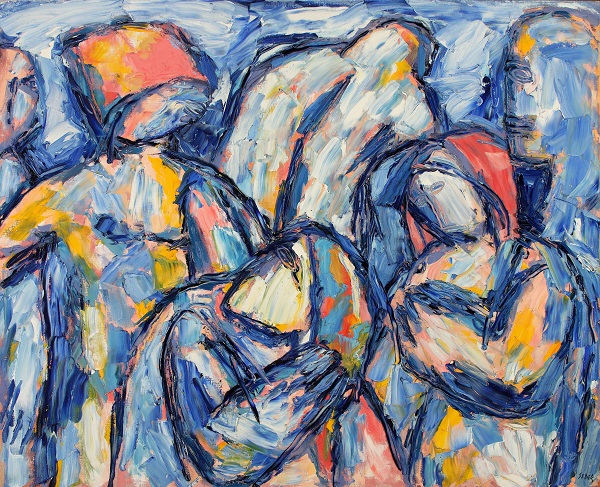 Bathers, 1974. / 75, oil on canvas, 95 x 120 cm
Bathers, 1974. / 75, oil on canvas, 95 x 120 cm
BIOGRAPHY:
Đuro Seder was born in 1927 in Zagreb; in 1951 he graduated in painting at the Academy of Fine Arts, class of Antun Mejzdić, going on to do post-graduate work with Marin Tartaglia. He was a member of the Gorgona group. Up to 1981 he worked as illustrator and graphic designer, and then started to work at the Academy of Fine Arts, at which he still keeps a studio to go with his status as emeritus professor. He published poems during the 1960s and 1970s, and in 1978 BiblioTeka published his collection of poems Otac iz lonca (Pop from a Pot). He has won numerous prizes and commendations from professional associations, and honours from local and national government. He is a member of HAZU, the Croatian Artists Association. His works are to be found in the most important private, national and ecclesiastical collections in Croatia.
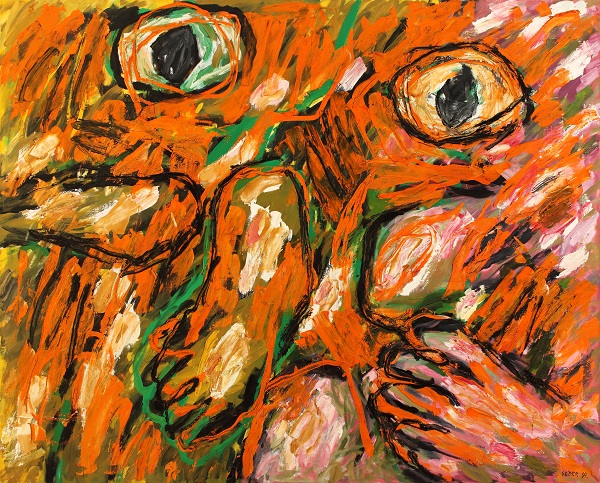
Big Eyes, 1977, oil on canvas, 150 x 185 cm
THROUGHOUT THE LAYERS OF THE FIGURE
Duration: 13.2.-8.3.2020.
Curator: Rozana Vojvoda & Jelena Tamindžija
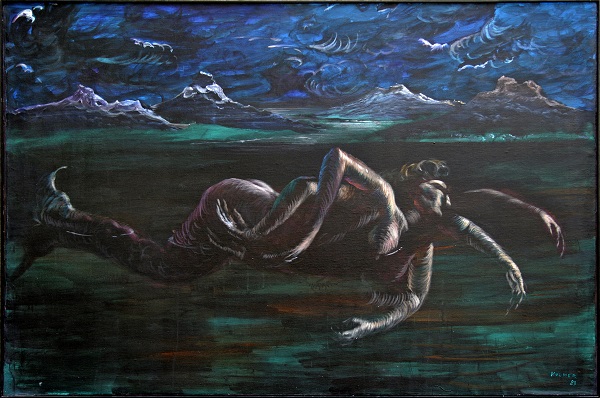 Ferdinand Kulmer
Ferdinand Kulmer
ARTISTS:
Boris Bućan (1947), Jože Ciuha (1924 – 2015), Viktor Daldon (1972), Mijo Demović (1953), Ferdinand Kulmer (1925 – 1998), Ljubo Ivančić (1925 – 2003), Marojica Mitrović (1950), Lukša Peko (1941), Miljenko Stančić (1926 – 1977), Milovan Stanić (1929 – 1989), Damir Stojnić (1972) i Ivo Šebalj (1912 – 2002)
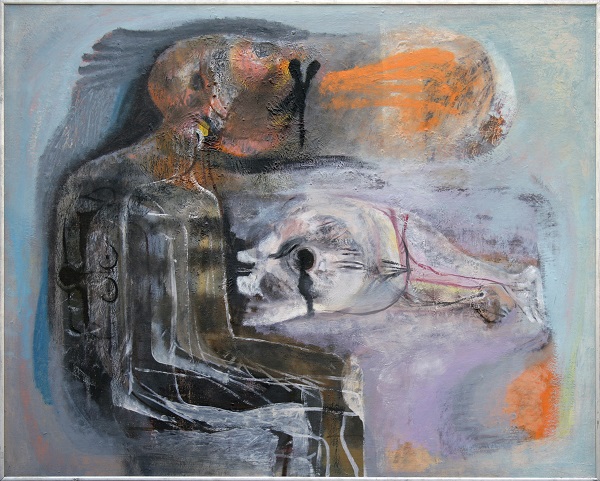 Ivo Šebalj
Ivo Šebalj
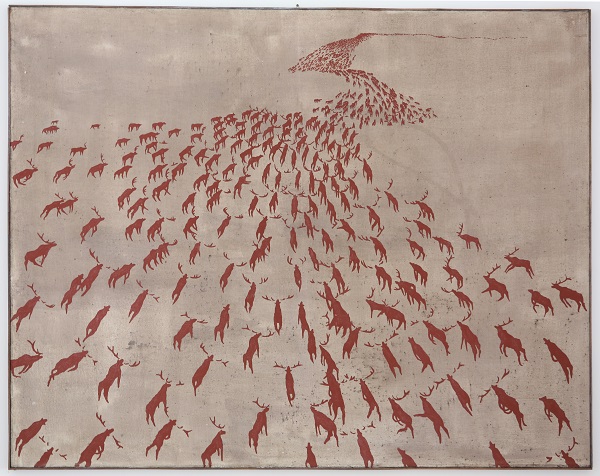
Damir Stojnić
ANTUN MASLE
Retrospective exhibition to honor the 100th anniversary of birth of Antun Masle
Duration: 14.12.2019. - 1.3.2020.
Curator: Igor Zidić
.jpg)
Antun Masle
Antun Masle is one of the most important painters from Dubrovnik who belongs to so called Dubrovnik coloristic circle, a distinctive variant of "southern expressionism". In his portraits, landscapes and still lifes, Antun Masle uses color similar to Fovist principles, and in his later works approaches the art brute. The author of the exhibition is one of the most famous Croatian historians, theorists and art critics, Igor Zidic.
.jpg)
Autoportret s pticom, 1968., ulje/papir, 29 x 23 cm, slikarovi nasljednici, Dubrovnik
The exhibited art is owned by national museums and galleries, such as the Museum of Modern Art Dubrovnik, the Split Art Gallery, the Zagreb Modern Gallery, the Museum of Contemporary Art in Zagreb, the Museum of Modern and Contemporary Art in Rijeka, the National Museum in Zadar, the City Museum in Rovinj, and artworks from various private collections will be on loan, of which the collection of the heirs of Antun Masle is of particular importance. Antun Masle had his last retrospective exhibition at the Museum of Modern Art Dubrovnik in 1984, so it will be valuable for introducing the younger generation to his work.
.jpg)
Aktovi pod maslinama, oko 1941., tempera / papir, 36 x 51 cm, slikarovi nasljednici, Dubrovnik
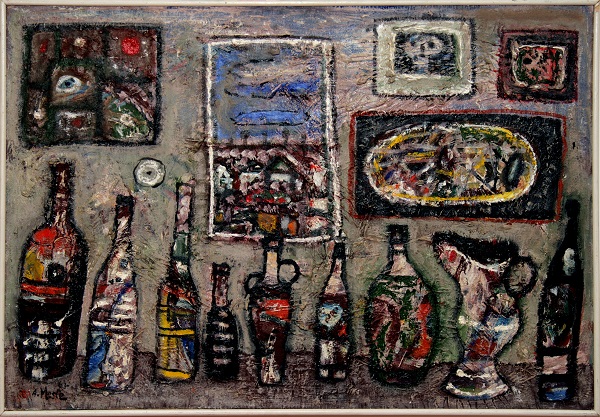
Boce i slike, 1963., ulje / platno






